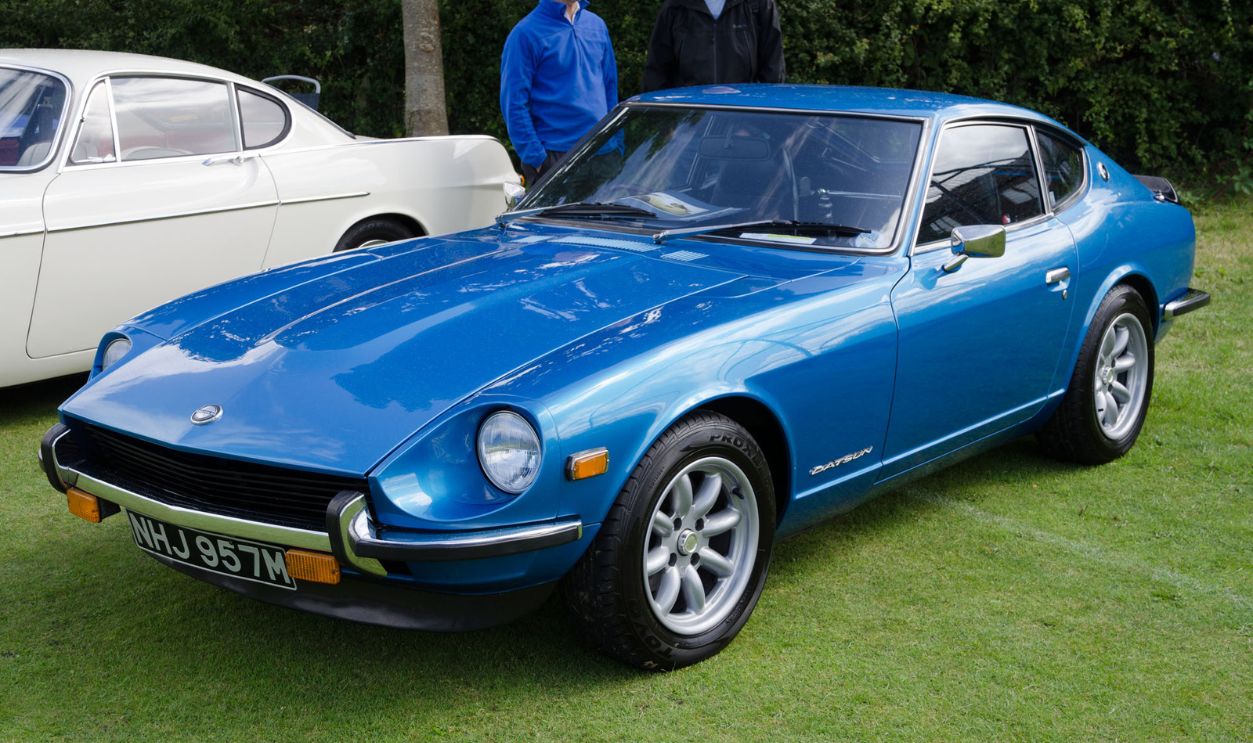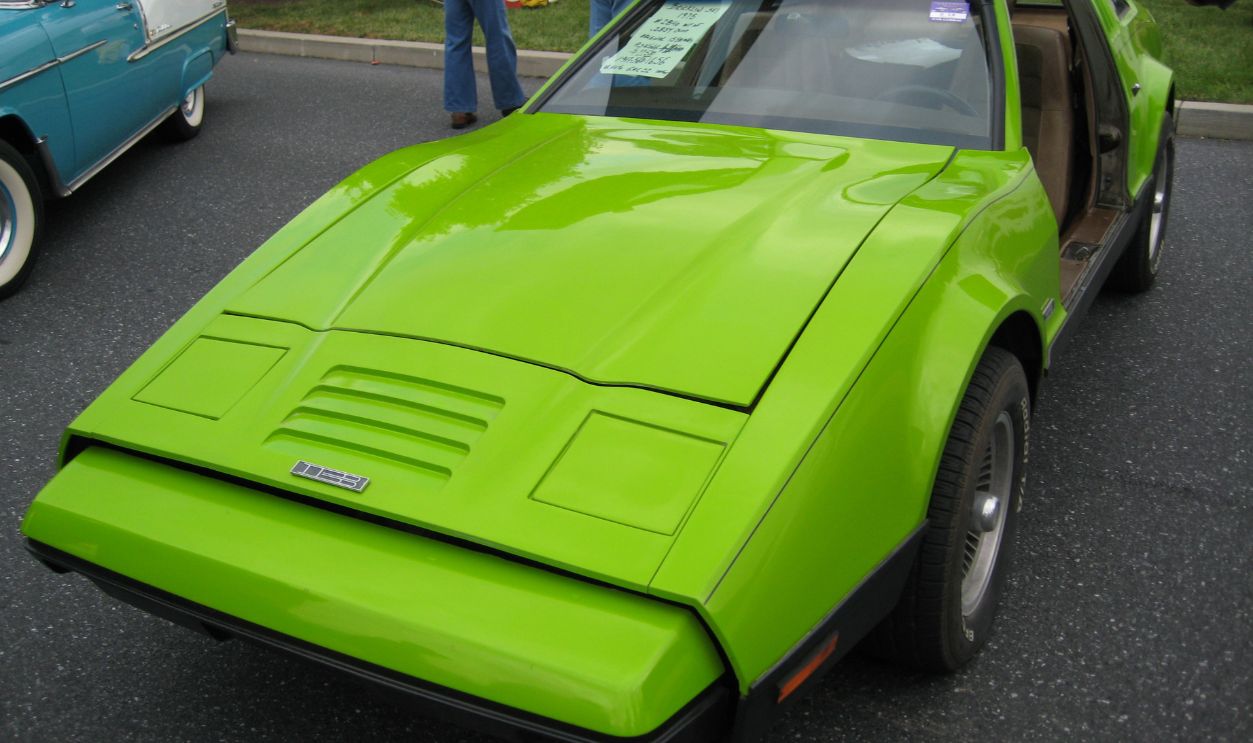It All Came Tumbling Down
The Bricklin SV-1 took the automotive industry by storm with its futuristic qualities and emphasis on safety. However, a few years after starting production, everything ended just as rapidly as it had begun.

The Visionary
Malcolm Bricklin combined his drive for entrepreneurship with a desire to challenge the status quo. Before the SV-1, Bricklin had already become famous for marketing Subaru vehicles in America. He then created the Bricklin SV-1 to offer exceptional safety features without sacrificing style and performance.
 Autobuff, CC BY 3.0, Wikimedia Commons
Autobuff, CC BY 3.0, Wikimedia Commons
Its Safety-Focused Design
Unlike many brands of that era that focused on performance and beauty, the SV-1 innovatively added advanced safety features into its design. Among the features are bumpers that absorb impact, fortified roll cages, and sturdier body panels. Because of this unconventional design, Bricklin was named an SV or "Safety Vehicle."
 Thomas doerfer, CC BY-SA 3.0, Wikimedia Commons
Thomas doerfer, CC BY-SA 3.0, Wikimedia Commons
Partners And Collaborations
Producing the SV-1 required the skills of several engineers and designers and the contributions of other stakeholders. Among those who contributed to this massive effort were automobile designer Herb Grasse and the Canadian government, which saw the business's economic potential.
 Andrew Bone, CC BY 2.0, Wikimedia Commons
Andrew Bone, CC BY 2.0, Wikimedia Commons
Development Challenges
Developers faced several challenges while building the Bricklin. The first obstacle was securing sufficient finances for the project because only a few people were willing to invest. Another issue was balancing the unique safety features with other aspects of the car. Malcolm had to come up with ways to fix these issues.
Production Location
One solution to the project's numerous challenges was moving production to New Brunswick, Canada. First, the Canadian government supplied resources to establish the production plant in New Brunswick. Furthermore, the location offered the brand access to the North American market.
 MapGrid, CC BY-SA 4.0, Wikimedia Commons
MapGrid, CC BY-SA 4.0, Wikimedia Commons
The Assembly Line Process
After several research and experiments, the brand built an assembly line as complex as its unique product. The line required precise coordination, and groups of highly skilled employees were needed to manage this setup and produce the sophisticated Bricklin SV-1.
 dave_7, CC BY-SA 2.0, Wikimedia Commons
dave_7, CC BY-SA 2.0, Wikimedia Commons
The First Prototype
They say the first step is always the hardest. So was the release of the SV-1's prototype. Yet, its eventual production proved that the company has transitioned from concept to reality. This prototype was exactly as Malcolm wanted: a beauty crafted with great attention to detail.
 ilikewaffles11, CC BY 2.0, Wikimedia Commons
ilikewaffles11, CC BY 2.0, Wikimedia Commons
The SV-1's Mass Production
Mass production of the Bricklin began in 1974 and was done quickly to meet the high demand for the vehicle. During this time, the manufacturing plant operated at peak capacity, often releasing hundreds of cars per batch. However, the rush resulted in poor quality controls and system failures.
 Andrii Yalanskyi, Shutterstock
Andrii Yalanskyi, Shutterstock
Production Numbers
The brand needed more than innovation and ambition to remain afloat. Between 1974 and 1975, only about 2,854 units of the vehicle were released. This low figure was mainly due to technical challenges, fluctuating market tastes, and insufficient resources. Conversely, the low numbers made the car rarer than expected.
Exterior Design Philosophy
The addition of safety features didn't come at the expense of exterior beauty—far from that. Instead, the body design was based on a strong devotion to aesthetics, aerodynamics, and safety. Important aspects of the design included the fiberglass and acrylic body panels, which helped reduce the vehicle's weight.
The Iconic Gullwing Doors
Gullwing doors were added to the Bricklin SV-1 to make it more appealing. Each door opened and closed using the car's hydraulic system. Although gullwing doors made entering or exiting the vehicle easier, especially in confined spaces, the designers found it difficult to handle the doors' weight.
Color Options
The Bricklin SV-1's acrylic body enabled the car to be painted in different shades, making each vehicle peculiar and attractive. Safety Orange, Green, White, Red, and Safety Sultan were chosen to increase their visibility on the road and make them stand out from traditional colors.
Customization Options
The SV-1's customization options were limited, probably because Malcolm wanted to maintain strict quality control and keep his product unique. However, some buyers found ways to modify their cars using aftermarket parts. Their modifications often focused on the suspension, front disc, and rear drum brakes.
Interior Design
The Bricklin's cabin provided optimum comfort and luxury. Its dashboard layout was user-focused, with its controls positioned within the reach of the driver and occupants. Features like adjustable seating and climate control systems enhanced the atmosphere and luxurious feel of the car.
 Christopher Ziemnowicz, Wikimedia Commons
Christopher Ziemnowicz, Wikimedia Commons
Dashboard Display
The SV-1's dashboard featured different gauges, including a speedometer, tachometer, fuel gauge, and auxiliary gauges. These displays provided drivers with data on engine performance, temperature, and battery status. Each was easy to read to minimize distractions.
Engine Options
Two main engine options were available for the Bricklin SV-1. One was the AMC 360 V8 engine, known for its performance and reliability; the other was the more powerful Ford 351 Windsor V8 engine. Both were paired with a three-speed automatic transmission, which helped the brand compete in races.
 Christopher Ziemnowicz, Wikimedia Commons
Christopher Ziemnowicz, Wikimedia Commons
Details Of Safety Features
The first part of Bricklin's Safety was its integrated roll cage for enhanced structural resistance in case of a collision. Additionally, the bumpers absorb impact and prevent injuries and damages from low-speed collisions. Other features include seat belts and padded interior surfaces, which help minimize injuries during accidents.
 forgeracing.pl, CC BY-SA 4.0, Wikimedia Commons
forgeracing.pl, CC BY-SA 4.0, Wikimedia Commons
Air Conditioning As A Standard Feature
Another way Bricklin showcased its foresight was by including air conditioning as part of its standard offer. In the mid-1970s, air conditioning was an optional feature for most luxury vehicles. The feature confirmed that the brand was also concerned about passengers' comfort.
Exhibition At Automotive Shows
The SV-1 was first made public at the New York International Auto Show in 1974. That was when it began to capture people's attention with its safety, performance, and aesthetics. Another thing it did capture was the scrutiny of critics who wondered at the practicality of the vehicle.
 Nrbelex, CC BY-SA 3.0, Wikimedia Commons
Nrbelex, CC BY-SA 3.0, Wikimedia Commons
Custom-Built Engine For Canadian Models
Although many Bricklin models had a 360-cubic-inch AMC V8 or a 351-cubic-inch Ford V8, some versions released into the Canadian market had engines specially tuned to meet the country's strict emission laws. These modified engines had better timing, fuel mixture, and exhaust systems.
 Christopher Ziemnowicz, Wikimedia Commons
Christopher Ziemnowicz, Wikimedia Commons
Advanced Seat Design
The Bricklin SV-1's seats also had modernized designs. They included extra padding and contoured shapes for better seating comfort on long journeys. The seats were also adjustable so customers could sit comfortably regardless of age or size.
 Hugh Llewelyn, CC BY-SA 2.0, Wikimedia Commons
Hugh Llewelyn, CC BY-SA 2.0, Wikimedia Commons
Technical Specifications Overview
The SV-1 measured about 175 inches in length, 67 inches in width, and 51 inches in height. It showcased a miniature yet bold appearance. A wheelbase of about 96 inches improved stability and handling, while the engine and transmissions supplied power and smooth engagement.
Aluminum Bumpers
Designed to absorb impact more effectively than traditional steel, aluminum bumpers helped reduce potential damage in a collision. Though lighter, they were more expensive to produce and could cost more to replace after an accident.
Convertible Prototype
To offer an open riding experience, the Bricklin team considered building a convertible model. The plan was to include retractable roof mechanisms that would preserve the car's safety features. Sadly, financial setbacks prevented the project from materializing as planned.
Special Models
Two special SV-1 models were released during the car's production run. In 1975, the company announced that it would release a special edition called the "Chairman." This version would have larger engines than the base model, a black interior, and a black exterior with gold stripes. Work began in earnest, but the design never reached production.
 Riley, CC BY 2.0, Wikimedia Commons
Riley, CC BY 2.0, Wikimedia Commons
Racing Ambitions
Malcolm had many dreams for the SV-1, including making it more than a car for daily commutes. He also wanted it to be a high-performance sports car. Perhaps he wanted something of everything. Features like the V8 engine and aerodynamic body suit the vehicle for this purpose.
 Christopher Ziemnowicz, Wikimedia Commons
Christopher Ziemnowicz, Wikimedia Commons
Market Reception
The Bricklin SV-1's innovative features received mixed reactions from the market. While some accepted the car for its focus on safety, others criticized the pairing of a V8 with a three-speed automatic. Critics felt a five-speed manual would have been preferable. The gullwing doors were also criticized for being too clumsy.
 Christopher Ziemnowicz, Wikimedia Commons
Christopher Ziemnowicz, Wikimedia Commons
Comparison With Competitors
In the 1970s sports car market, the Bricklin SV-1 had better safety features than competitors like the Chevrolet Corvette, Porsche 911, and Datsun 240Z. Some of these brands performed better and were affordable. However, investors saw Bricklin's innovation as a good sign and threw in their money.
 SG2012, CC BY 2.0, Wikimedia Commons
SG2012, CC BY 2.0, Wikimedia Commons
Celebrity Ownership And Endorsements
Country musician Johnny Cash was one of the celebrities who purchased an SV-1. He displayed the car in a TV commercial, emphasizing its special safety features. Also, Paul Lynde, a famous actor and comedian, owned and endorsed the Bricklin for its sophistication.
 Columbia Records, Wikimedia Commons
Columbia Records, Wikimedia Commons
Financial Struggles
Before long, the business began to face serious financial struggles. Insufficient funds led to production delays and cost overruns, which tarnished the company's reputation. The production cost, which was significantly higher than initially calculated, worsened Bricklin's economic woes.
Investor Lawsuits And Shareholder Disputes
Investors who had initially expressed hope in Bricklin's profitability were taken aback by the difficulties the company was experiencing. Many became increasingly frustrated with the issue and had to resort to legal disputes and lawsuits. This was the beginning of Malcolm's downfall.
Supplier And Contractor Disputes
Aside from investors, the company was also sued by suppliers and contractors for breach of contract. Unpaid invoices and financial disputes continued to disrupt production because the suppliers began to hold back necessary car parts. These delays also impacted the quality of the vehicles produced.
Interest From American Motors Corporation (AMC)
At the peak of Bricklin's financial struggles, AMC considered acquiring the company or entering into a partnership with it. The idea was that AMC would provide the resources and personnel needed to rescue Bricklin. However, AMC itself began drowning in debt and could not rescue Bricklin.
 American Motors Corporation, Wikimedia Commons
American Motors Corporation, Wikimedia Commons
Bricklin's Eventual Collapse
Mounting financial burdens made it difficult for the company to get more funds. Investors, like the government, no longer trusted the business to make a profit, and they eventually revoked their support. Efforts to rescue the brand were unfruitful, leading to the hard decision to stop production.
Attempting A Comeback
In the early 2000s, Malcolm tried reviving Bricklin. He planned to build a better model using recent technological advancements. So, he announced plans to start work on the SV-2. And just like his first attempt, this, too, wasn't successful due to a lack of funding.
 Christopher Ziemnowicz, Wikimedia Commons
Christopher Ziemnowicz, Wikimedia Commons
The Bricklin EV Venture
In 2002, Malcolm once again ventured into the automotive industry. He partnered with Visionary Vehicles to introduce a new line of electric vehicles into the US. Their collaboration was later canceled and the project was abandoned due to financial struggles and other challenges.
Sought By Collectors
Due to its limited production numbers, the Bricklin SV-1 has become highly sought-after by collectors. Additionally, enthusiasts also appreciate its safety features, output, and aesthetics. Their activities have resulted in increased demand for old units of the Bricklin SV-1.
 Ventura19, CC BY-SA 3.0, Wikimedia Commons
Ventura19, CC BY-SA 3.0, Wikimedia Commons
Restoration And Preservation Efforts
Many collectors and fans are restoring old versions of the car. Refurbishing an SV-1 can be challenging because it requires a deep understanding of its design. This has led several experts to combine their knowledge and resources to restore available models of the car.
 Christopher Ziemnowicz, Wikimedia Commons
Christopher Ziemnowicz, Wikimedia Commons
Current Market Value
The car's legacy as a pioneer in automobile safety generally affects its value. Collectors' high demand for the Bricklin SV-1 has also increased its price. Its value, however, depends more on conditions, originality, and origin. Still, well-preserved ones can cost between $30,000 and $50,000.
Enthusiast Communities
A dedicated community of Bricklin fans currently provides guidance and resources to anyone undertaking a restoration project. These communities exist as online forums, clubs, and events, providing free information for the public. Their efforts have contributed to the preservation of the SV-1 legacy.
The SV-1 In Popular Culture
Like many iconic cars, the Bricklin SV-1 has become a part of pop culture. It has been featured in movies like Demon Seed in 1977 and The Junkman in 1982. Many of its advanced features have motivated different automakers to be ambitious in their design.
 Glen Bowman, CC BY 2.0, Wikimedia Commons
Glen Bowman, CC BY 2.0, Wikimedia Commons
The Legacy Of Malcolm Bricklin
Malcolm Bricklin is still recognized worldwide as a pioneer and innovator. His dedication to creating a unique and futuristic vehicle demonstrates his belief in the power of new ideas and modern technologies to change the industry.
 JOHN LLOYD, CC BY 2.0, Wikimedia Commons
JOHN LLOYD, CC BY 2.0, Wikimedia Commons
Bricklin's Other Ventures
Malcolm's failures in the SV-1 and SV-2 adventures didn't mean he was a complete failure. He had been pivotal in helping Subaru establish a firm presence in the American market in the 1960s. Malcolm also successfully marketed the Yugo, an affordable compact car, to the US in the 1980s.
Lessons Learned
The story of Bricklin presents several valuable lessons for entrepreneurs and innovators. Even though the project was well ahead of its time, Malcolm believed unwaveringly in its feasibility while almost neglecting the complexity of the automobile industry. More research would have helped him balance innovation with practicality.
 ilikewaffles11, CC BY 2.0, Wikimedia Commons
ilikewaffles11, CC BY 2.0, Wikimedia Commons


























